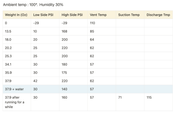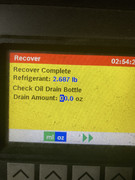Ok folks, updates.
First of all, I pulled my compressor and drained it of oil.
I turned it upside down and turned and turned on the crankshaft and only a little less than an ounce came out. Kind of weird.
I was able to add in 4.5oz of new pag oil, no problem.
After I bolted it back in, I drew a vacuum and held it overnight. Today, I worked on charging it.
It was extremely hot today, about 100* and 35% humidity.
I did ti all while holding the throttle open to 1400 rpm.
Here are my results. I ended up putting in 37.9 oz of r134a. Coldest I could get the vent temps to was 57*.
I thought I was recording suction and discharge temps but I realized at the end I was doing it wrong. So I only have suction and discharge temps for the final charge amount.
You'll see at the end, I sprayed the condenser with a garden hose and the pressure dropped significantly. I was wondering if this would point to a lack of proper airflow. I did order a 16" fan from SPAL to replace my 14" no-name brand fan, so that'll be going in. Maybe it'll help.

Ater the garden spray at the end, I let it run for sveral more minutes and it seemed to reach a settle pressure on high and low. My final results at 100* ambient, 35% humidity were:
Low: 30 // High: 160 // Vent Temp: 57* // Suction Temp: 71* // Discharge Temp: 115*
Wondering if I should still add more, or what?


